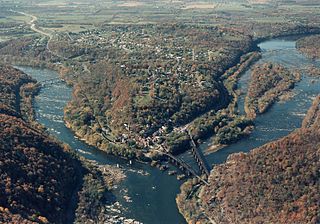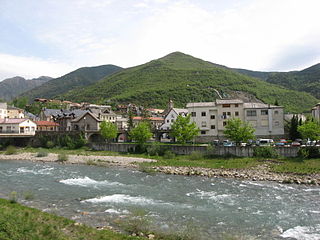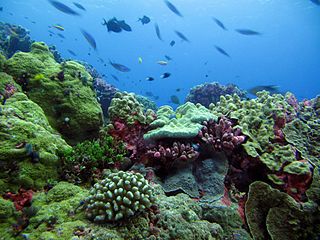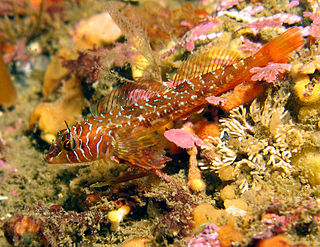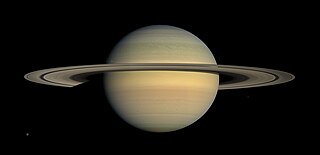
Lake Austin, formerly Lake McDonald, is a water reservoir on the Colorado River in Austin, Texas. The reservoir was formed in 1939 by the construction of Tom Miller Dam by the Lower Colorado River Authority. Lake Austin is one of the seven Highland Lakes created by the LCRA, and is used for flood control, electrical power generation, and recreation.

Lake Vyrnwy is a reservoir in Powys, Wales, built in the 1880s for Liverpool Corporation Waterworks to supply Liverpool with fresh water. It flooded the head of the Vyrnwy valley and submerged the village of Llanwddyn. The Lake Vyrnwy Nature Reserve and Estate that surrounds the lake is jointly managed by the Royal Society for the Protection of Birds (RSPB) and Severn Trent Water and is a popular destination for ornithologists, cyclists and hikers. The reserve is designated as a national nature reserve, a Site of Special Scientific Interest, a Special Protection Area, and a Special Area of Conservation.
Lake Hammar is a saline lake in southeastern part of Iraq within the Hammar Marshes. It has an area of 600-1,350 km². Water level in the lake fluctuates, with maximum depths varying from 1.8 metres (winter) to 3.0 metres (spring). The lake is an important wetland site for birds. The native inhabitants are Marsh Arabs, some of whom occupy villages on artificial, floating islands.
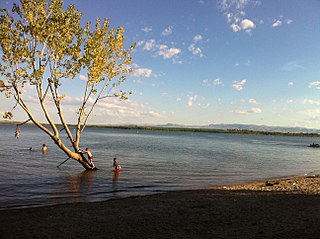
The Deer Flat National Wildlife Refuge is an important breeding area for mammals, birds, and other animals. The National Wildlife Refuge is located on land surrounding Lake Lowell, just outside Nampa, Idaho. It serves as a resting and wintering area for birds, including mallards and Canada geese, along the Pacific Flyway and was named a "Globally Important Bird Area" by the American Bird Conservancy.

Lake Qaraoun is an artificial lake or reservoir located in the southern region of the Beqaa Valley, Lebanon. It was created near Qaraoun village in 1959 by building a 61-metre-high (200 ft) concrete-faced rockfill dam in the middle reaches of the Litani River. The reservoir has been used for hydropower generation, domestic water supply, and for irrigation of 27,500 hectares.

In planetary geology, a mensa is a flat-topped prominence with cliff-like edges. The term is derived from the Latin word for table, and has the same root as the Spanish word for table, mesa. Mensa is used in the same manner as mesa is used in the Southwest United States.

A dam failure is a catastrophic type of failure characterized by the sudden, rapid, and uncontrolled release of impounded water or the likelihood of such an uncontrolled release.

The lakes of Titan, Saturn's largest moon, are bodies of liquid ethane and methane that have been detected by the Cassini–Huygens space probe, and had been suspected long before. The large ones are known as maria (seas) and the small ones as lacūs (lakes).

Kraken Mare is the largest known body of liquid on the surface of Saturn's moon Titan. It was discovered by the space probe Cassini and was named in 2008 after the Kraken, a legendary sea monster.

Ligeia Mare is a lake in the north polar region of Titan, the planet Saturn's largest moon. It is the second largest body of liquid on the surface of Titan, after Kraken Mare. Larger than Lake Superior on Earth, it is mostly composed of liquid methane, with unknown but lesser components of dissolved nitrogen and ethane, as well as other organic compounds. It is located at 78° N, 249° W, and has been fully imaged by the Cassini spacecraft. Measuring roughly 420 km (260 mi) by 350 km (217 mi) across, it has a surface area of about 126,000 km2, and a shoreline over 2000 km (1240 mi) in length. The lake may be hydrologically connected to the larger Kraken Mare. Its namesake is Ligeia, one of the sirens in Greek mythology.
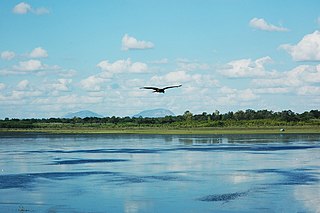
Hesaraghatta Lake is a manmade reservoir located 18 km to the north-west of Bengaluru in Karnataka state, India. It is a fresh water lake created in the year 1894 across the Arkavathy River to meet the drinking water needs of the city. Sir K. Seshadri Iyer, the then Dewan of erstwhile Mysore state and the then Chief Engineer of Mysuru, M. C. Hutchins, planned to build the scheme called the "Chamarajendra Water Works" to store a three-years' water supply to the city.

The Harlan County Reservoir includes a dam and a reservoir of 13,250 acres (54 km2) located in Harlan County in south-central Nebraska. Its southernmost part extends into northern Phillips County, Kansas. The reservoir is formed by a dam constructed by the U.S. Army Corps of Engineers on the Republican River, which starts in Colorado and ends in Kansas.

Canelles Reservoir is a reservoir in the Pre-Pyrenees area in Spain. It is located in the Noguera Ribagorzana river bordering the province of Huesca, Aragon and the province of Lleida, Catalonia. It was bulid by the spanish power utility ENHER.

Neagh Lacus is one of a number of hydrocarbon lakes found on Saturn's largest moon, Titan. The lake is composed of liquid methane and ethane, and was detected by the Cassini space probe.

Hammar Lacus is one of a number of hydrocarbon seas and lakes found on Saturn's largest moon, Titan.

Müggel Lacus is one of a number of hydrocarbon seas and lakes found on Saturn's largest moon, Titan.

The Alarcón Dam is a gravity dam on the upper course of the Júcar River. It is located 6 kilometers from Alarcón, in the province of Cuenca, in the autonomous community of Castilla-La Mancha, Spain.



